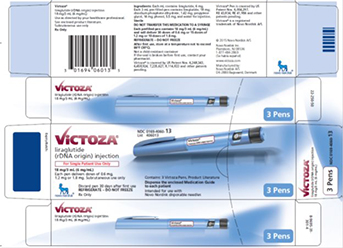FDA records indicate that there are no current recalls for this drug.
Are you a medical professional?
Trending Topics
Victoza Recall
Get an alert when a recall is issued.
Questions & Answers
Side Effects & Adverse Reactions
There is currently no warning information available for this product. We apologize for any inconvenience.
Legal Issues
There is currently no legal information available for this drug.
FDA Safety Alerts
There are currently no FDA safety alerts available for this drug.
Manufacturer Warnings
There is currently no manufacturer warning information available for this drug.
FDA Labeling Changes
There are currently no FDA labeling changes available for this drug.
Uses
Victoza is indicated as an adjunct to diet and exercise to improve glycemic control in adults with type 2 diabetes mellitus.
- •
- Victoza is not recommended as first-line therapy for patients who have inadequate glycemic control on diet and exercise because of the uncertain relevance of the rodent C-cell tumor findings to humans. Prescribe Victoza only to patients for whom the potential benefits are considered to outweigh the potential risk [see Warnings and Precautions (5.1)].
- •
- Based on spontaneous postmarketing reports, acute pancreatitis, including fatal and non-fatal hemorrhagic or necrotizing pancreatitis has been observed in patients treated with Victoza. Victoza has not been studied in patients with a history of pancreatitis. It is unknown whether patients with a history of pancreatitis are at increased risk for pancreatitis while using Victoza. Other antidiabetic therapies should be considered in patients with a history of pancreatitis.
- •
- Victoza is not a substitute for insulin. Victoza should not be used in patients with type 1 diabetes mellitus or for the treatment of diabetic ketoacidosis, as it would not be effective in these settings.
- •
- The concurrent use of Victoza and prandial insulin has not been studied.
History
There is currently no drug history available for this drug.
Other Information
Victoza contains liraglutide, an analog of human GLP-1 and acts as a GLP-1 receptor agonist. The peptide precursor of liraglutide, produced by a process that includes expression of recombinant DNA in Saccharomyces cerevisiae, has been engineered to be 97% homologous to native human GLP-1 by substituting arginine for lysine at position 34. Liraglutide is made by attaching a C-16 fatty acid (palmitic acid) with a glutamic acid spacer on the remaining lysine residue at position 26 of the peptide precursor. The molecular formula of liraglutide is C172H265N43O51 and the molecular weight is 3751.2 Daltons. The structural formula (Figure 1) is:

Figure 1 Structural Formula of liraglutide
Victoza is a clear, colorless solution. Each 1 mL of Victoza solution contains 6 mg of liraglutide. Each pre-filled pen contains a 3 mL solution of Victoza equivalent to 18 mg liraglutide (free-base, anhydrous) and the following inactive ingredients: disodium phosphate dihydrate, 1.42 mg; propylene glycol, 14 mg; phenol, 5.5 mg; and water for injection.
Sources
Victoza Manufacturers
-
Novo Nordisk
![Victoza (Liraglutide (Rdna Origin) Injection) Injection, Solution [Novo Nordisk]](/wp-content/themes/bootstrap/assets/img/loading2.gif)
Victoza | Novo Nordisk
![Victoza (Liraglutide (Rdna Origin) Injection) Injection, Solution [Novo Nordisk] Victoza (Liraglutide (Rdna Origin) Injection) Injection, Solution [Novo Nordisk]](/wp-content/themes/bootstrap/assets/img/loading2.gif)
Victoza can be administered once daily at any time of day, independently of meals, and can be injected subcutaneously in the abdomen, thigh or upper arm. The injection site and timing can be changed without dose adjustment.
For all patients, Victoza should be initiated with a dose of 0.6 mg per day for one week. The 0.6 mg dose is a starting dose intended to reduce gastrointestinal symptoms during initial titration, and is not effective for glycemic control. After one week at 0.6 mg per day, the dose should be increased to 1.2 mg. If the 1.2 mg dose does not result in acceptable glycemic control, the dose can be increased to 1.8 mg.
When initiating Victoza, consider reducing the dose of concomitantly administered insulin secretagogues (such as sulfonylureas) to reduce the risk of hypoglycemia [see Warnings and Precautions (5.4) and Adverse Reactions (6)].
When using Victoza with insulin, administer as separate injections. Never mix. It is acceptable to inject Victoza and insulin in the same body region but the injections should not be adjacent to each other.
Victoza solution should be inspected prior to each injection, and the solution should be used only if it is clear, colorless, and contains no particles.
If a dose is missed, the once-daily regimen should be resumed as prescribed with the next scheduled dose. An extra dose or increase in dose should not be taken to make-up for the missed dose.
Based on the elimination half-life, patients should be advised to reinitiate Victoza at 0.6 mg if more than 3 days have elapsed since the last Victoza dose. This approach will mitigate any gastrointestinal symptoms associated with reinitiation of treatment. Upon reinitiation, Victoza should be titrated at the discretion of the prescribing healthcare provider.
Login To Your Free Account



![Victoza (Liraglutide (Rdna Origin) Injection) Injection, Solution [Novo Nordisk]](http://dailymed.nlm.nih.gov/dailymed/image.cfm?setid=5a9ef4ea-c76a-4d34-a604-27c5b505f5a4&name=49f302f5-f315-48b8-83a4-6ca56f01fded-24.jpg)